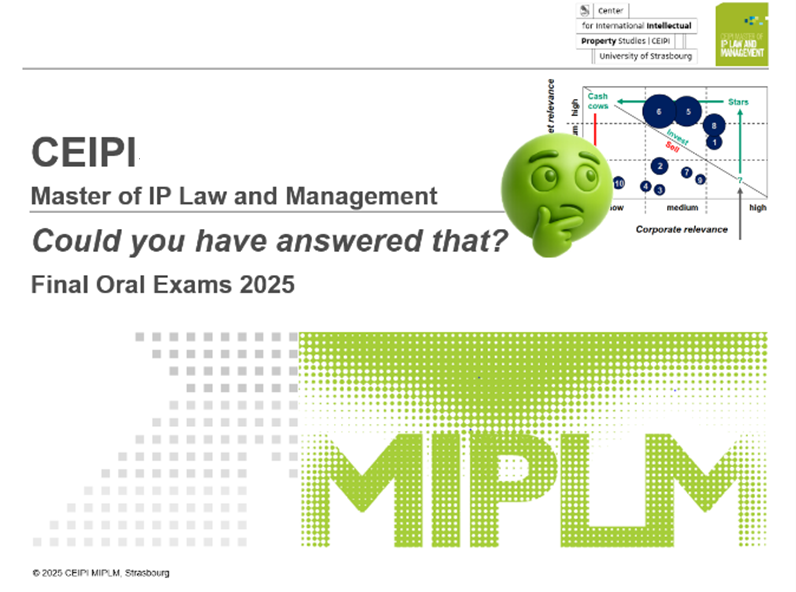Could You Have Answered That? Cracking the CEIPI MIPLM 2025 Exam on IP Portfolio Strategy
The oral exam of the CEIPI Master Program in Intellectual Property Law and Management is known for its practical complexity. In this blog post from our series “Could You Have Answered That?”, we explore Task 3 — a core challenge for aspiring IP managers, focusing solely on the IP management part. We’ll walk through the question, explain the relevant concepts covered in the course, highlight which IP Subject Matter Experts contribute on the IP Business Academy platform, and present a sample solution.
1 . The Exam Task 3: Portfolio Analysis and Positioning
Case:
PlayGame, a video game console producer, holds 150 patents and applications but has no strategic alignment behind its IP filings. Due to rapid changes in the industry, the management team requests an assessment of their competitive positioning in market-relevant technologies and patents.
Task:
As an IP management consultant, you must:
- Develop a portfolio concept for PlayGame and a competitor.
- Present criteria and indicators for both axes of the portfolio diagram.
The task requires a strategic evaluation of PlayGame’s patent portfolio in relation to internal strengths and external market factors.
2 . What You Learn in the CEIPI MIPLM Lecture
The corresponding MIPLM lectures (Modules M1-21 and M1-2) equip participants with key tools for strategic IP portfolio analysis. Let’s summarize the key teachings:
A) Portfolio as a Strategic Tool
The idea of a portfolio is rooted in financial theory (e.g., Markowitz) and adapted for IP strategy. A patent or technology portfolio is a 2D matrix that plots internal strengths (x-axis) against external relevance (y-axis).
- Internal axis (Resource Strength):
Measures the quality and competitiveness of the owned IP rights. Criteria include:
– Number of patents
– Patent strength (citations, scope)
– Exploitation potential (licensing, product integration)
– R&D alignment and know-how access
- External axis (Technology Attractiveness):
Reflects market relevance and growth potential. Criteria include:
– Customer or industry need
– Technological advancement or potential
– Substitutability
– Alignment with future trends
This framework is drawn from the Pfeiffer Portfolio, the BCG Matrix, and technology portfolios by Ernst and Brockhoff.
B) Value Through Visualization
Portfolio diagrams provide:
- Strategic clarity (Where are we vs. where we should be?)
- Guidance for resource allocation (Invest, Select, Harvest, Divest)
- A basis for stakeholder communication
C) Strategic Fit
As taught in M1-2, portfolio analysis helps match internal capabilities with external opportunities — known as strategic fit.
3 . IP Subject Matter Experts on the IP Business Academy Platform
The IP Business Academy provides deep insights into real-world application of portfolio analysis through content from leading experts, including:
- Bas Albers: IP Strategies for SME
- Erdem Kaya: IP and Startups
- Maria Boicova-Wynants: IP and the Metaverse
- Dominique Christ: IP Benchmarking
- Oliver Baldus: Lean IP
Learners can find deep dives, articles here:
- 🔎 𝗜𝗣 𝗠𝗮𝗻𝗮𝗴𝗲𝗺𝗲𝗻𝘁 𝗚𝗹𝗼𝘀𝘀𝗮𝗿𝘆 entry: Portfolio Management
- 🔗𝗱𝗜𝗣𝗹𝗲𝘅 digital IP lexicon page: Patent Portfolio Analysis
- 🔗𝗱𝗜𝗣𝗹𝗲𝘅 digital IP lexicon page: Indicator-based Patent Evaluation
- 📑 𝗜𝗣 𝗠𝗮𝗻𝗮𝗴𝗲𝗺𝗲𝗻𝘁 𝗟𝗲𝘁𝘁𝗲𝗿: Firm Performance and IP Management
- 📑 𝗜𝗣 𝗠𝗮𝗻𝗮𝗴𝗲𝗺𝗲𝗻𝘁 𝗟𝗲𝘁𝘁𝗲𝗿: Value-Orientated IP Management
- 🎧 𝗜𝗣 𝗠𝗮𝗻𝗮𝗴𝗲𝗺𝗲𝗻𝘁 𝗩𝗼𝗶𝗰𝗲: Episode #47 Video Game Patents and IP Strategy
4 . Sample Solution: Portfolio Concept for PlayGame
Here is a structured approach to solving the task, with example indicators.
Step 1: Define Success Objects
We focus on patent families as the unit of analysis — specifically those linked to core technologies (e.g., chip design, user interface, connectivity).
Step 2: Develop the Axes
- Y-Axis: External Technology Attractiveness. Criteria (scored 1–5):
- Market demand for the technology
- Technological trend alignment (AI, XR, streaming)
- Substitution risk
- Competitive pressure (other players entering the space)
- Ecosystem fit (platform compatibility)
- Example Indicator:
Patent set for “low-latency streaming” ranks 5 for market demand but 2 for substitution risk = weighted attractiveness score: 4.2. - X-Axis: Internal Resource Strength. Criteria (scored 1–5):
- Patent family size and scope
- Citations and legal robustness
- Integration into products
- Exploitation readiness (licensability)
- Alignment with R&D roadmap
- Example Indicator:
Patent set for “modular controller interface” has few citations, limited product use, and low licensing activity = score: 2.3.
Step 3: Create the Portfolio Diagram
- Each bubble represents a patent cluster, size based on commercial relevance (e.g., revenue contribution).
- Quadrants:
- High-High: Strategic Core — Retain and invest
- High-Low: Growth Opportunities — Strengthen or partner
- Low-High: Risky Stars — Consider licensing or sale
- Low-Low: Sunset — Divest or allow to lapse
Step 4: Benchmark Against Competitor
- Use a key competitor like Sony PlayStation.
- Extract public patent data from EPO / USPTO databases.
- Match technology fields (e.g., controller, cloud gaming).
- Apply the same scoring matrix.
This allows comparative positioning in areas like “gesture-based interface” or “5G connectivity modules.”
Step 5: Recommendations
- Strengthen internal IP capabilities where external tech is attractive but PlayGame is weak (e.g., partner with research labs or acquire startups).
- Abandon or monetize low-value legacy patents.
- Protect new R&D in VR gaming — currently underrepresented but strategically relevant.
5 . Conclusion
The Task 3 exam question from the 2025 CEIPI MIPLM program exemplifies how IP portfolio analysis is no longer a legal afterthought but a strategic necessity. Through proper use of internal and external indicators, and tools like the Pfeiffer or BCG matrix, IP managers can help companies align their innovation with market demands and defend their competitive edge.
And yes — if you studied the lecture content carefully, drew from expert insights on the IP Business Academy, and practiced real-world comparisons — you could have answered that.



